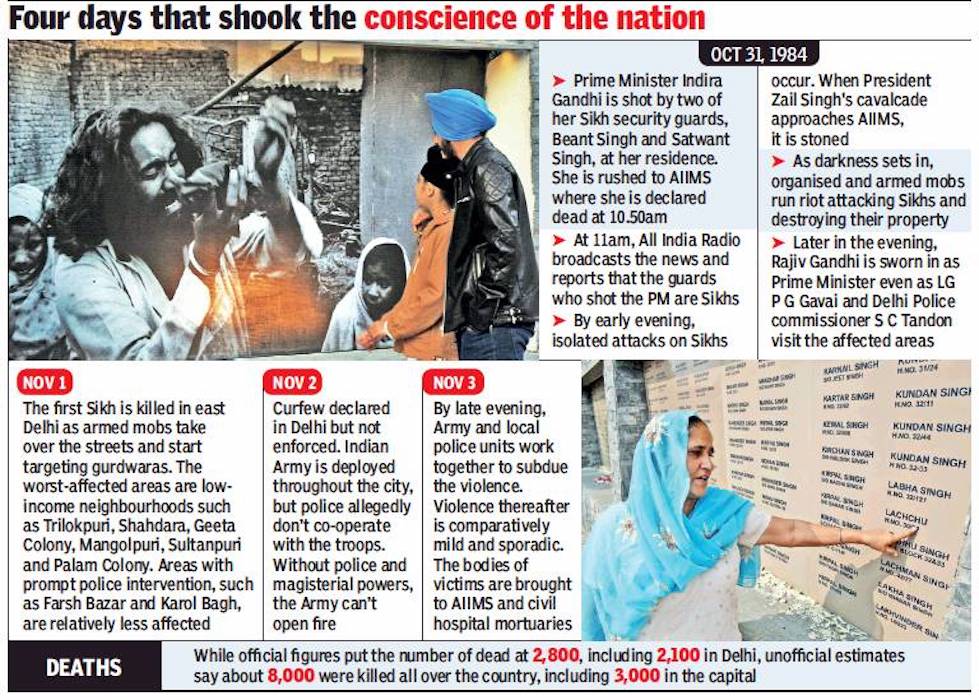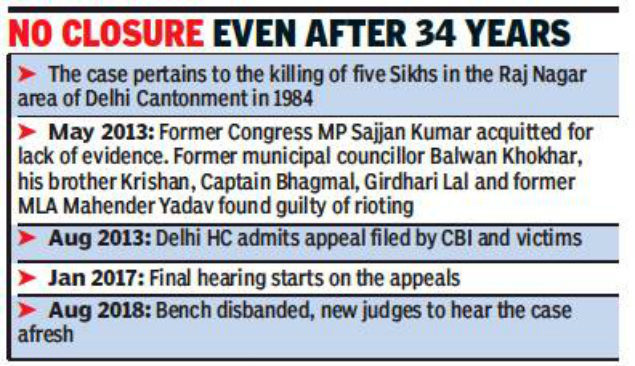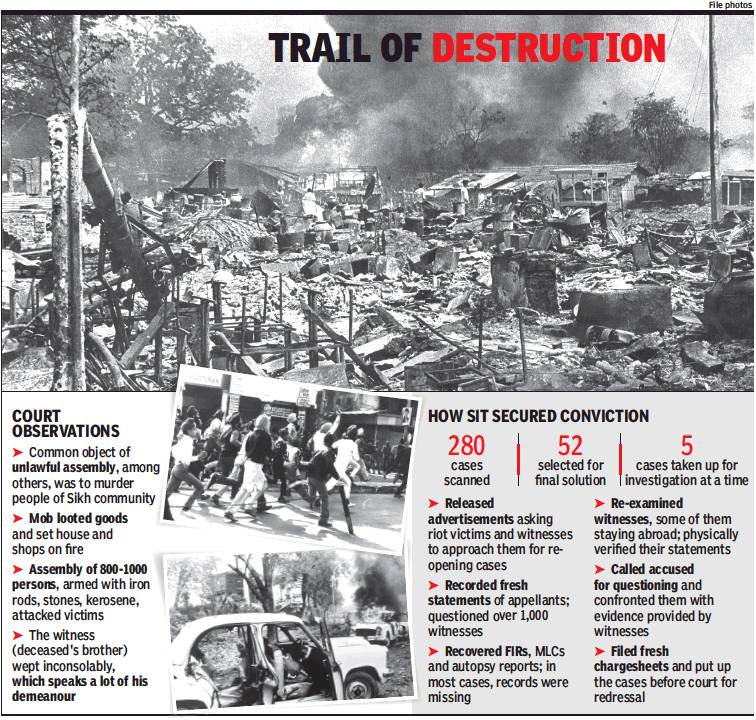1984 riots: India
(→Status in 2018) |
|||
| Line 19: | Line 19: | ||
==Status in 2018== | ==Status in 2018== | ||
[https://timesofindia.indiatimes.com/city/delhi/1984-riots-judges-transfer-wrecks-hopes/articleshow/65393011.cms Abhinav Garg, 1984 riots: Judge’s transfer wrecks hopes, August 14, 2018: ''The Times of India''] | [https://timesofindia.indiatimes.com/city/delhi/1984-riots-judges-transfer-wrecks-hopes/articleshow/65393011.cms Abhinav Garg, 1984 riots: Judge’s transfer wrecks hopes, August 14, 2018: ''The Times of India''] | ||
| + | |||
[[File: Proceedings of the 1984 riots case in the Delhi HC- Status, as in 2018.jpg|Proceedings of the 1984 riots case in the Delhi HC- Status, as in 2018 <br/> From: [https://timesofindia.indiatimes.com/city/delhi/1984-riots-judges-transfer-wrecks-hopes/articleshow/65393011.cms Abhinav Garg, 1984 riots: Judge’s transfer wrecks hopes, August 14, 2018: ''The Times of India'']|frame|500px]] | [[File: Proceedings of the 1984 riots case in the Delhi HC- Status, as in 2018.jpg|Proceedings of the 1984 riots case in the Delhi HC- Status, as in 2018 <br/> From: [https://timesofindia.indiatimes.com/city/delhi/1984-riots-judges-transfer-wrecks-hopes/articleshow/65393011.cms Abhinav Garg, 1984 riots: Judge’s transfer wrecks hopes, August 14, 2018: ''The Times of India'']|frame|500px]] | ||
| Line 33: | Line 34: | ||
Senior advocate H S Phoolka, who has for years spearheaded the fight for justice, admitted that the victims were very agitated and frustrated due to the delay. “They even wanted to go to the Supreme Court to stop Justice Mittal’s transfer till a judgement was delivered, but I persuaded them not to do it, because she is a good judge,” Phoolka told TOI. | Senior advocate H S Phoolka, who has for years spearheaded the fight for justice, admitted that the victims were very agitated and frustrated due to the delay. “They even wanted to go to the Supreme Court to stop Justice Mittal’s transfer till a judgement was delivered, but I persuaded them not to do it, because she is a good judge,” Phoolka told TOI. | ||
| − | + | ||
| + | =The SIT investigation= | ||
| + | ==The odds== | ||
| + | [https://epaper.timesgroup.com/Olive/ODN/TimesOfIndia/shared/ShowArticle.aspx?doc=TOIDEL%2F2018%2F11%2F15&entity=Ar00401&sk=5AE0164D&mode=text Somreet Bhattacharya, Missing papers, untraceable witnesses: SIT’s biggest enemy was time in ’84 riots, November 15, 2018: ''The Times of India''] | ||
| + | |||
| + | [[File: 2018- How the SIT secured convictions.jpg|2018- How the SIT secured convictions <br/> From: [https://epaper.timesgroup.com/Olive/ODN/TimesOfIndia/shared/ShowArticle.aspx?doc=TOIDEL%2F2018%2F11%2F15&entity=Ar00401&sk=5AE0164D&mode=text Somreet Bhattacharya, Missing papers, untraceable witnesses: SIT’s biggest enemy was time in ’84 riots, November 15, 2018: ''The Times of India'']|frame|500px]] | ||
| + | |||
| + | ''How Task Force Formed In 2015 Joined The Dots'' | ||
| + | |||
| + | The special investigation team, whose inquiry findings led to the conviction of two men in the anti-Sikh riots of 1984, was formed after the Union home minister ordered it on February 12, 2015. The SIT, comprising an IPS officer, a retired judge and a DANIPS officer, had the almost impossible task of conducting a fresh probe into all cases relating to the riots. | ||
| + | |||
| + | Over the passage of 30 years, some complainants and witnesses had moved out from their original colonies, while others had died. Even the policemen who had originally handled the cases had retired or left Delhi. The riot sites too had undergone changes since. | ||
| + | |||
| + | However, the SIT, assisted by a team of around 50 cops, started a systematic effort to join the dots. Led by IPS officer Anurag Kumar, DANIPS officer Kumar Gyanesh and justice Rakesh Kapoor, the SIT was notified as a police station with jurisdiction over entire Delhi. Immediately after its constitution, it issued advertisements requesting riot victims to once again report their cases. The panel members scanned through 650 cases, sorting out 280 which were unresolved. | ||
| + | |||
| + | In most of the cases, the witnesses or the accused were no longer alive. Documents related to some medico-legal cases and autopsies were discovered to be missing, but if found damaged, were retrieved with the help of conservation experts. In some cases, victims had kept documentary records secure along with photographic evidence. | ||
| + | |||
| + | Enquiring into a case registered at Mehrauli police station, the SIT realised that a politician had been acquitted despite a chargesheet filed against him in 1985. The FIR named Surjeet Singh, Sangat Singh and Kuldeep Singh as witnesses in the case. The cops contacted Sangat Singh, who now lives in Jalandhar, and recorded his statement. He also assisted police in contacting the others. | ||
| + | |||
| + | The SIT discovered that though the politician was named in the FIR, it was his associates Naresh Sehrawat and Yashpal Singh who murdered Sangat’s family members during the riots. The two men led a thousand-strong mob in Mahipalpur village and burnt down the grocery shop of Hardev Singh, Sangat’s brother. Hardev, brother Kuldeep and cousin Avtar Singh took shelter with their neighbour Surjeet Singh. The mob detected them there, and SIT said Sehrawat poured kerosene on Surjeet’s belongings and set his house on fire. | ||
| + | |||
| + | According to the investigation, the rioters used Surjeet’s kirpan to stab him, Hardev, Avtar, Sangat and Kuldeep. Before ransacking the house, they threw the injured men off the first floor terrace. The five were admitted to Safdarjung Hospital, where Hardev and Avtar died. After recovery, some family members shifted to Punjab, others went overseas. The cops contacted a relative, Ratan Singh, who had identified the bodies, and the Italy resident agreed to depose. He recorded his statement in September last year. Both Sehrawat and Yashpal Singh were chargesheeted based on his statement. | ||
| + | |||
| + | The investigative team filed the chargesheet on January 31. During the trial, 18 prosecution witnesses were examined. On October 31 last year, charges for one of the cases registered in Mehrauli were framed after final arguments. | ||
| + | |||
| + | The SIT is now probing three cases registered in Janakpuri, Vikaspuri and Saraswati Vihar, all of which name Congress leader Sajjan Kumar as the accused. Kumar has been questioned five times in the past three years. Some of the witnesses now staying in the US are being examined before chargesheets are framed in the cases. Three others cases are pending investigation. The SIT has also transferred a case that was being probed by CBI. | ||
Revision as of 13:34, 16 November 2018
This is a collection of articles archived for the excellence of their content. |
Contents |
1-4 November: The riots

From: January 11, 2018: The Times of India
See graphic:
The Anti-Sikh riots of 1-4 November, 1984: a timeline
Proceedings in Delhi HC
Status in 2018
Abhinav Garg, 1984 riots: Judge’s transfer wrecks hopes, August 14, 2018: The Times of India

From: Abhinav Garg, 1984 riots: Judge’s transfer wrecks hopes, August 14, 2018: The Times of India
Many victims of the 1984 anti-Sikh riots expecting relief from court felt as if the clock had turned back. They had hoped for a decision on their plea filed in 2013 in the Delhi high court. But with Justice Gita Mittal’s transfer as chief justice of J&K high court, the bench she headed for dedicated hearing on a batch of appeals and revision petitions stood disbanded, leaving people like 80-year-old Jagdish Kaur — who was hoping for some closure after 34 years — distraught.
It means the matter that HC wanted to fast-track will have to be heard “de-novo” (once again) by a new bench, erasing the progress made since January 2017.
After taking charge as acting chief justice, Mittal had retained the riot cases she was earlier hearing and fixed every Thursday and Friday of a week for dedicated sessions. The move came after HC took note of the “delay occasioned in adjudication of these matters, which have their genesis in offences of the year 1984” and added that “certainly, a quietus needs to be brought to the entire litigation at the earliest”. But “quietus” appears far fetched for Jagdish and other widows such as Sampooran Kaur who lost their husbands or sons in the riots 35 years ago in riots that broke out in Delhi Cantt area following the assasination of Prime Minister Indira Gandhi.
Jagdish, CBI’s prime witness in the case lost her husband Kehar Singh; elder son Gurpreet and cousins Narinder Pal Singh, Raghuvinder Singh and Kuldeep Singh in the riots. Apprehensive of further delay in the appeal, she had only last month filed an application urging HC to conduct day-to-day hearing to enable an early judgment. “The appellant has withstood the test of time, in as much as it has been 34 years since the tragic and brutal murder of her family members. It is her life’s objective she may see final adjudication of the matter in her life time,” her plea said.
These appeals had reached HC after a trial court acquitted Congress leader Sajjan Kumar in 2013 but held five others guilty. While the CBI challenged Kumar’s acquittal along with the victim families, the latter also demanded enhancement of punishment to the convicted men. These were cases that were re-opened in 2005 on the recommendations of Justice Nanawati Commission leading to registration of FIRs. Speaking to TOI, Nirprit Kaur rued the “missed opportunity” for victims. Kaur, who used to travel from Chandigarh to attend the Thursday/Friday hearings, sounded crestfallen. “We are back to zero, because the matter which had been kept part heard since 2017, will now be heard once again. For Yakub Memon the court can remain open entire night but for us even twice a week we couldn’t get a proper hearing. Loss is ours,” she said.
Senior advocate H S Phoolka, who has for years spearheaded the fight for justice, admitted that the victims were very agitated and frustrated due to the delay. “They even wanted to go to the Supreme Court to stop Justice Mittal’s transfer till a judgement was delivered, but I persuaded them not to do it, because she is a good judge,” Phoolka told TOI.
The SIT investigation
The odds

From: Somreet Bhattacharya, Missing papers, untraceable witnesses: SIT’s biggest enemy was time in ’84 riots, November 15, 2018: The Times of India
How Task Force Formed In 2015 Joined The Dots
The special investigation team, whose inquiry findings led to the conviction of two men in the anti-Sikh riots of 1984, was formed after the Union home minister ordered it on February 12, 2015. The SIT, comprising an IPS officer, a retired judge and a DANIPS officer, had the almost impossible task of conducting a fresh probe into all cases relating to the riots.
Over the passage of 30 years, some complainants and witnesses had moved out from their original colonies, while others had died. Even the policemen who had originally handled the cases had retired or left Delhi. The riot sites too had undergone changes since.
However, the SIT, assisted by a team of around 50 cops, started a systematic effort to join the dots. Led by IPS officer Anurag Kumar, DANIPS officer Kumar Gyanesh and justice Rakesh Kapoor, the SIT was notified as a police station with jurisdiction over entire Delhi. Immediately after its constitution, it issued advertisements requesting riot victims to once again report their cases. The panel members scanned through 650 cases, sorting out 280 which were unresolved.
In most of the cases, the witnesses or the accused were no longer alive. Documents related to some medico-legal cases and autopsies were discovered to be missing, but if found damaged, were retrieved with the help of conservation experts. In some cases, victims had kept documentary records secure along with photographic evidence.
Enquiring into a case registered at Mehrauli police station, the SIT realised that a politician had been acquitted despite a chargesheet filed against him in 1985. The FIR named Surjeet Singh, Sangat Singh and Kuldeep Singh as witnesses in the case. The cops contacted Sangat Singh, who now lives in Jalandhar, and recorded his statement. He also assisted police in contacting the others.
The SIT discovered that though the politician was named in the FIR, it was his associates Naresh Sehrawat and Yashpal Singh who murdered Sangat’s family members during the riots. The two men led a thousand-strong mob in Mahipalpur village and burnt down the grocery shop of Hardev Singh, Sangat’s brother. Hardev, brother Kuldeep and cousin Avtar Singh took shelter with their neighbour Surjeet Singh. The mob detected them there, and SIT said Sehrawat poured kerosene on Surjeet’s belongings and set his house on fire.
According to the investigation, the rioters used Surjeet’s kirpan to stab him, Hardev, Avtar, Sangat and Kuldeep. Before ransacking the house, they threw the injured men off the first floor terrace. The five were admitted to Safdarjung Hospital, where Hardev and Avtar died. After recovery, some family members shifted to Punjab, others went overseas. The cops contacted a relative, Ratan Singh, who had identified the bodies, and the Italy resident agreed to depose. He recorded his statement in September last year. Both Sehrawat and Yashpal Singh were chargesheeted based on his statement.
The investigative team filed the chargesheet on January 31. During the trial, 18 prosecution witnesses were examined. On October 31 last year, charges for one of the cases registered in Mehrauli were framed after final arguments.
The SIT is now probing three cases registered in Janakpuri, Vikaspuri and Saraswati Vihar, all of which name Congress leader Sajjan Kumar as the accused. Kumar has been questioned five times in the past three years. Some of the witnesses now staying in the US are being examined before chargesheets are framed in the cases. Three others cases are pending investigation. The SIT has also transferred a case that was being probed by CBI.